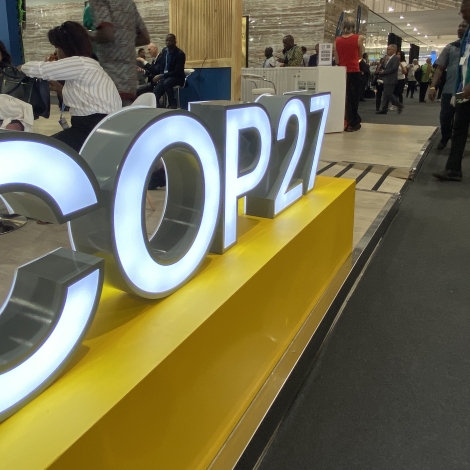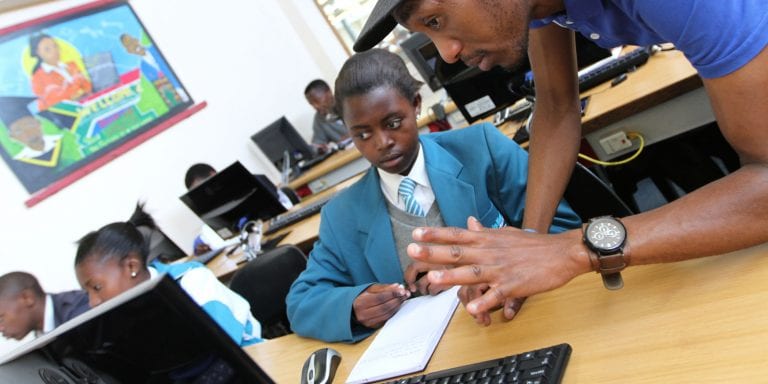The business of COP 27 took place on buses, in queues and in chance encounters wandering among the pavilions. Those shared spaces where attendees of different social and professional strata mingled democratized networking opportunities at the latest Conference of the Parties, the United Nations’ global climate summit. In the era of virtual meetings, sharing a seat with another person on a bus to a COP 27 venue approaches a justification of the in-person event. A theme that emerged from conversations with strangers and chanced-upon panel discussions at COP 27 was the frustration with the slow pace of change. That complaint was voiced in large part by the people who will bear the brunt of climate change: the vulnerable communities in the Global South.
I had the privilege and pleasure of participating in COP 27 as part of the Global Council for Science and Environment delegation. I was also a panelist in a Physicians for Social Responsibility session that met in the Climate Justice Pavilion. I immersed myself in COP 27 as a scholar of the built environment. My work centers on the delivery of sustainable and resilient housing solutions that advance environmental sustainability objectives while also unlocking health and well-being outcomes for low-income communities.
Learn more about E4C’s Impact Projects.
In one chance meeting, the voices of three young activists from the Amazon Forest singing and speaking in their indigenous language drew me into a session in which they discussed their work, goals, and aspirations for their communities. They had two concerns. The first was that their communities have been let down by a series of projects that had not consulted local authorities, thus missing marks that should have been highly prioritized. The second is that positive change within the Amazon rainforest that is not matched by sustainable practices outside the region will still leave them vulnerable to extreme weather events. Their concerns were not isolated or unique. In fact, men and women of all ages from the Global South expressed similar sentiments.
With just eight years left to reach the UN’s Sustainable Development Goals by 2030, we must move beyond roadmaps to act on implementation plans.
Having global “all-in” roadmaps gives frameworks that can help concentrate our efforts on a few vital actions that can help move the work into the “business-unusual” pathway, one in which the ambition to hold global warming to a cap of 1.5° Celsius is translated into reality. There are some understandable concerns that with just eight years left to reach the UN’s Sustainable Development Goals by 2030, we must move swiftly beyond publishing roadmaps. We need to roll out and act on implementation plans.
The biggest barrier to implementation is finance. The GCSE pavilion, where I was a delegate, hosted a coffee dialogue featuring elected officials from California. The officials provided highlights of their journey to the historic $54 billion climate budget in their state, as well as details of what is covered by the budget. Everyone present acknowledged that this a huge victory for climate action. But as we celebrated, we were also reminded that the benefits to California are not extended to the one-third of Pakistan that, at that time, was suffering the impacts of severe flooding, or the victims of the flooding that hit Nigeria in November and the other millions of people in vulnerable populations in the Global South.
The benefits to California are not extended to the millions of people in vulnerable populations in the Global South.
The global funding gap for climate action is in the range of trillions of dollars. This money could come from the private sector. Several pavilions featured discussions that outlined pathways to private finance. There were some shared concerns of a scale mismatch among those of us whose research and development work has a grassroots focus.
Some of the private sector actors suggested that the threshold for a small project is $100 million. They are not looking for pilots and case studies. They want 10x thinking! The goal could be achieved through forging transformative partnerships.
Pavilions hosted by a neutral convener, such as GSCE, universities and other non-profits, provided a platform where such partnerships could emerge. But those kinds of arrangements could happen anywhere, so what is the value of going to COP? I discovered value in the informal discourse that happens between people whose lives do not otherwise intersect. I served on a panel hosted by Physicians for Social Responsibility alongside three medical doctors from the United States, one of them an emergency room doctor. She pointed out that the synergies that emerged during our panel would be difficult to achieve in our business-as-usual activities.
A gentleman from Grenada with a dream of going around the world to mobilize young people for climate action connected with allies representing several countries within a couple of minutes at the Coffee Dialogue hosted by GSCE. The shared bus rides to and from the venue leveled the playing field for networking. And so did the long queues for security screening at the entrance.
I left COP 27 before the overtime that resulted in an historic agreement. I understand the anger and frustration in the voices of the youth, women, people from the small island nations, indigenous communities, Sub-Saharan Africa, and other Global South countries. The inclusion of loss-and-damage provisions is a step in an initial right direction, but it is also understood that more needs to be done.
The journey to COP 28 is already underway. What we do today matters a great deal in terms of ensuring that the concerns of the historically disadvantaged communities are addressed. The Engineering for Change community could play a pivotal role here. Even where some funds have been made available, a human-centered engineering design criteria in climate action remains a work in progress.
E4C Impact Projects can showcase how we as a global community could work synergistically to translate climate action roadmaps into implementation plans.
There are some participation and representation barriers that can be linked to the digital divide. We, the E4C community, can co-develop pathways to viable solutions. I envisage an E4C-curated digital platform that bridges on-going open science efforts with citizen science initiatives. We can mainstream existing peer review efforts that credit citizens science for content that they generate.
The E4C Impact Projects can also play a pivotal role in showcasing how we as a global community could work synergistically to translate existing climate action roadmaps into implementation plans. As part of my own preparations for COP 28, I will be sponsoring another Impact Project – please consider participating through partnering with existing partners or sponsoring a project.
About the Author
Dr. Esther Obonyo is the Director of the Global Building Network led by the Pennsylvania State University and an Associate Professor of Engineering Design and Architectural Engineering at Penn State. She has worked as a Construction Engineer, Project Manager and Innovations Analyst in several Engineering and Construction Companies in Kenya, the UK and the USA, and she has had several NSF awards including an International Research Experiences for Students directed at Developing Global Scientist and Engineers in Kenya and Tanzania. She is also the lead PI for an NSF Belmont Forum Collaborative Research Action Disaster Risk Reduction project.

